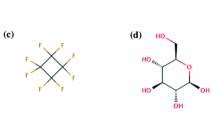Abstract
An implicit solvent model described by a non-simple dielectric medium is used for the prediction of hydration free energies on the dataset of 47 molecules in the SAMPL4 challenge. The solute is represented by a minimal parameter set model based on a new all atom force-field, named the liquid simulation force-field. The importance of a first solvation shell correction to the hydration free energy prediction is discussed and two different approaches are introduced to address it: either with an empirical correction to a few functional groups (alcohol, ether, ester, amines and aromatic nitrogen), or an ab initio correction based on the formation of a solute/explicit water complex. Both approaches give equally good predictions with an average unsigned error <1 kcal/mol. Chemical accuracy is obtained.


Similar content being viewed by others
References
Mikulskis P, Genheden S, Rydberg P, Sandberg L, Olsen L, Ryde U (2012) J Comput Aided Mol Des 26:527–541
Sandberg L, Edholm O (2002) J Chem Phys 116:2935–2944
Sandberg L, Casemyr R, Edholm O (2002) J Phys Chem B 106:7889–7897
Guthrie JP (2014) SAMPL4, A blind challenge for computational solvation free energies: the compounds considered. J Comput Aided Mol Des (in press)
Mobley DL, Wymer K, Lim NM (2014) Blind prediction of solvation free energies from the SAMPL4 challenge. J Comput Aided Mol Des (in press)
Desnoyers JE, Verrall RE, Conway BE (1965) J Chem Phys 43:243–250
Chandler D (2005) Nature 437:640–647
Reiss H, Frisch HL, Lebowitz JL (1959) J Chem Phys 31:369–380
Reiss H, Frisch HL, Helfand E, Lebowitz JL (1960) J Chem Phys 32:119–124
Rick SW (2004) J Chem Phys 120:6085–6093
Vrabec J, Stoll J, Hasse H (2001) J Phys Chem B 105:12126–12133
Bondi A (1964) J Phys Chem 68:441–451
Rowland RS, Taylor R (1996) J Phys Chem 100:7384–7391
(2013) LigPrep, version 2.6, Schrödinger, LLC, New York
(2013) MacroModel, version 10.0, Schrödinger, LLC, New York
(2013) Jaguar, version 8.0, Schrödinger, LLC, New York
Jorgensen WL, Chandrasekhar J, Madura JD, Impey RW, Klein ML (1983) J Chem Phys 79:926–935
Plyasunova NV, Plyasunov AV, Shock EL (2004) Intern J Thermophys 25:351–360
Abraham MH, Andonian-Haftvan J, Whiting GS, Leo A, Taft RS (1994) J Chem Soc Perkin Trans 2:1777–1791
Acknowledgments
I would like to thank Ulf Ryde for fruitful discussions and valuable comments. I am also grateful to Andreas Klamt for providing me with his lowest energy conformer of mannitol (SAMPL4_001).
Author information
Authors and Affiliations
Corresponding author
Rights and permissions
About this article
Cite this article
Sandberg, L. Predicting hydration free energies with chemical accuracy: the SAMPL4 challenge. J Comput Aided Mol Des 28, 211–219 (2014). https://doi.org/10.1007/s10822-014-9725-3
Received:
Accepted:
Published:
Issue Date:
DOI: https://doi.org/10.1007/s10822-014-9725-3




